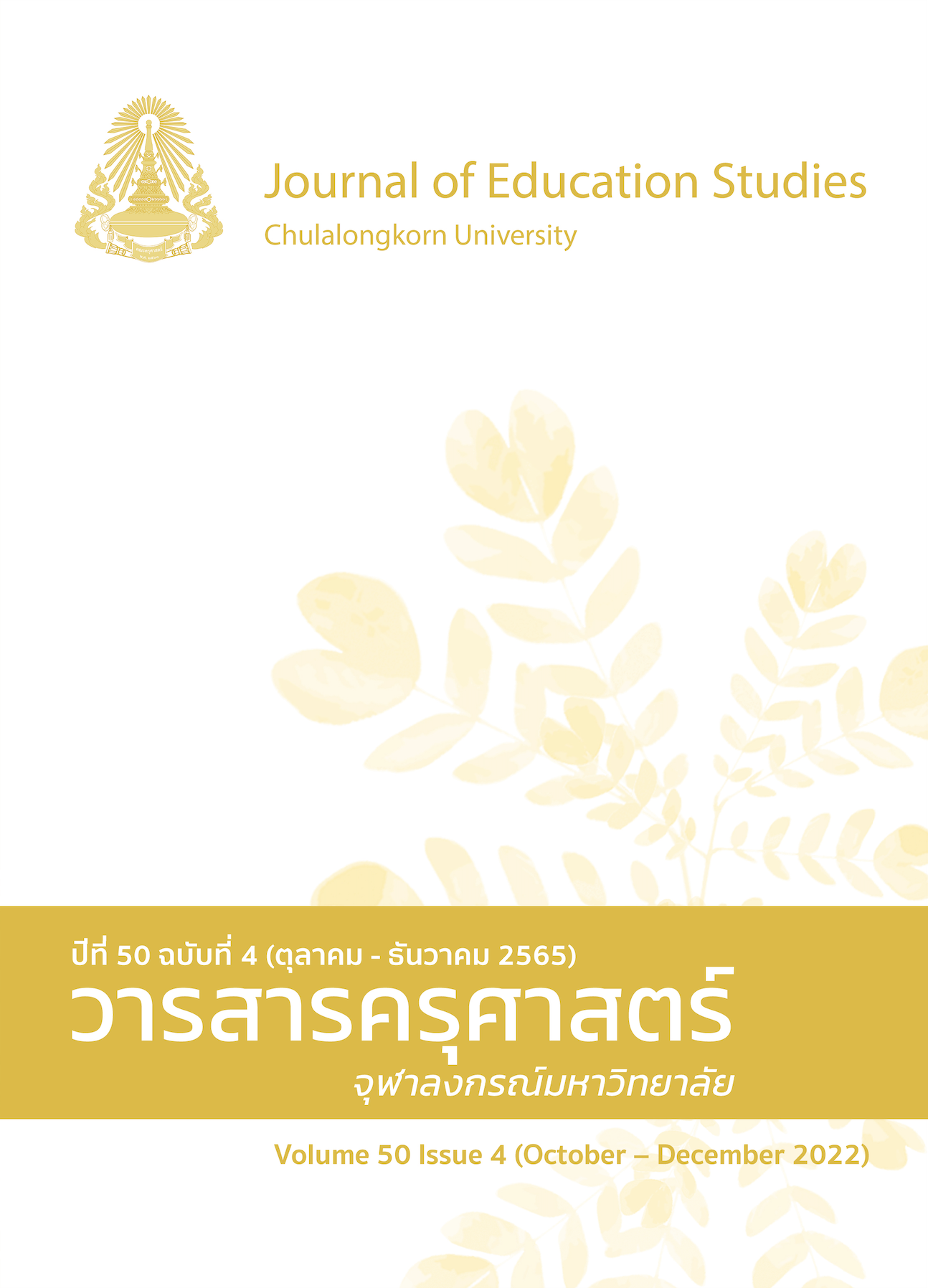A Confirmatory Factors Analysis of New First-graders’ Readiness
DOI:
https://doi.org/10.14456/educu.2022.38Keywords:
educational transition, school readiness, confirmatory factor analysisAbstract
A transition from kindergarten to first grade classrooms matters for all children. Supports ensuring that the children would be able to perfectly adjust themselves during the transition is crucial. This study aimed to analyze the readiness for school of new first-grade students by using Confirmatory Factor Analysis (CFA). The participants were kindergarten teachers (working with children aged 5–6), first-grade teachers, parents of kindergarteners (children aged 5–6), and parents of first graders. A survey of expectations for the readiness of children to enter first grade was completed by those two groups of participants, and CFA were used to analyze the collected data. The result shows that the readiness of new first graders consisted of six aspects: (1) physical growth and body movement, (2) pre-academic skills, (3) social skills,
(4) self-sufficiency skills, (5) personal qualities and disposition, and (6) self-discipline. Within a group of teachers, the construct validity of the readiness was confirmed with the model (c2 (8, N=204)= 14.690, p=.0655, (c2/df = 1.836, RMSEA=0.085, SRMR=0.004). Likewise, those within a group of parents was confirmed with the model (c2(5, N=2,861) = 19.582, p = .002, c2/df = 3.916, RMSEA = 0.032, SRMR = 0.001).
References
ภาษาไทย
กมลทิพย์ นิ้มคธาวุธ และ ศศิลักษณ์ ขยันกิจ. (2561). บทบาทครูในการสร้างรอยเชื่อมต่อทางการศึกษาของเด็กเพื่อเข้าสู่
ชั้นประถมศึกษาปีที่ 1. An Online Journal of Education, 13(2), 16–29.
จิตโสภิณ โสหา และ วรวรรณ เหมชะญาติ. (2560). การพัฒนากรอบแนวคิดการสร้างรอยเชื่อมต่อทางการศึกษาของเด็กอนุบาลเพื่อเข้าสู่ชั้นประถมศึกษา. An Online Journal of Education, 13(1), 325–338.
นงลักษณ์ วิรัชชัย. (2542). โมเดลลิสเรล : สถิติวิเคราะห์สำหรับการวิจัย. โรงพิมพ์แห่งจุฬาลงกรณ์มหาวิทยาลัย.
พนิตกานต์ อรรถสุขวัฒนา และ อุดมลักษณ์ กุลพิจิตร. (2560). การวิเคราะห์แนวปฏิบัติของครูในการสร้างรอยเชื่อมต่อจากบ้านสู่โรงเรียนอนุบาล. An Online Journal of Education, 13(2), 330–344.
ยศวีร์ สายฟ้า. (2557). รอยเชื่อมต่อการเรียนรู้ระหว่างชั้นเรียนอนุบาลและประถมศึกษา : ก้าวย่างที่สำคัญของเด็กประถมศึกษา. วารสารครุศาสตร์ จุฬาลงกรณ์มหาวิทยาลัย, 42(3), 143-159.
วรรณี แกมเกตุ. (2555). วิธีวิทยาการวิจัยทางพฤติกรรมศาสตร์ (พิมพ์ครั้งที่ 3). โรงพิมพ์แห่งจุฬาลงกรณ์มหาวิทยาลัย.
ภาษาอังกฤษ
Ben Shlomo, S., & Taubman-Ben-Ari, O. (2017). Child adjustment to first grade as perceived by the parents: The role of parents' personal growth. Stress and Health: Journal of the International Society for the Investigation of Stress, 33(2), 102-110. doi:10.1002/smi. 2678
Betts, L. R., Rotenberg, K. J., & Trueman, M. (2013). Young children's interpersonal trust consistency as
a predictor of future school adjustment. Journal of Applied Developmental Psychology, 34310-318. doi: 10.1016/j.appdev.2013.09.003
Cabrera, N. J. (2010). Father involvement and public policies. In M. E. Lamb (Ed.). The role of the father in child development (5th ed.). (pp. 517–550). Wiley.
Cadima, J., Doumen, S., Verschueren, K., & Buyse, E. (2015). Child engagement in the transition to school: Contributions of self-regulation, teacher–child relationships and classroom climate. Early Childhood Research Quarterly, 32(3), 1-12. doi:10.1016/j.ecresq.2015.01.008
Chan, W. L. (2012). Expectations for the transition from kindergarten to primary school amongst teachers, parents and children. Early Child Development and Care, 182(5), 639–664. http://dx.doi.org/10.
/03004430.2011.569543.
Chinsangthip, S., & Khayankij, S. (2020). Guidelines to build a smooth transition from home to preschool:
Parental roles in the Thai context. Asia-pacific Journal of Research, 14(2), 179-194.
Cook, K. D., & Coley, R. L. (2017). School Transition practices and children’s social and academic adjustment in kindergarten. Journal of Educational Psychology, 109(2), 166–177.
https://doi.org/10.1037/edu0000139
Correia, K., & Marques-Pinto, A. (2016). Adaptation in the transition to school: Perspectives of parents, preschool and primary school teachers. Educational Research, 58(3), 247–264.
https://doi.org/10.1080/00131881.2016.1200255
Duncan, G. J., Dowsett, C. J., Claessens, A., Magnuson, K., Huston, A. C., Klebanov, P., & Japel, C. (2007). School readiness and later achievement. Developmental Psychology, 43(6), 1428–1446.
http://dx.doi.org/10.1037/0012-1649.43.6.1428.
Hussain, H., Jesuvadian, M. K., Tay-Lim, J., Karuppiah, N., Norazman, L. Y., & Lim, L. (2018). Supporting children in their transition to primary 1: A guide for teachers and parents in Singapore. National Institute of Education, Nanyang Technological University.
Kumru, M. (2014). Teachers’ views on the qualifications that students should possess in the transition to primary education (case study: Sakarya). Procedia - Social and Behavioral Sciences, 116, 4333–4337. https://doi.org/10.1016/j.sbspro.2014.01.942
Lau, E. Y. H., & Power, T. G. (2018). Parental involvement during the transition to primary school: Examining bidirectional relations with school adjustment. Children and Youth Services Review, 88, 257–266. https://doi.org/10.1016/j.childyouth.2018.03.018
Niklas, F., Cohrssen, C., Vidmar, M., Segerer, R., Schmiedeler, S., Galpin, R., & Tayler, C. (2018). Early childhood professionals’ perceptions of children’s school readiness characteristics in six countries.
International Journal of Educational Research, 90, 144–159.
https://doi.org/10.1016/j.ijer.2018.06.001
Niklas, F., Tayler, C., & Cohrssen, C. (2017). What is school readiness and how are smooth transitions to school supported? In T. Bentley, & G. C. Savage (Eds.). Educating Australia: Challenges for the decade ahead (pp. 117–132). Melbourne University Press.
Rimm-Kaufman, S. E., Larsen, R. A., Baroody, A. E., Curby, T. W., Ko, M., Thomas, J. B., & DeCoster, J. (2014). Efficacy of the responsive classroom approach: results from a 3-year, longitudinal randomized controlled trial. American Educational Research Journal, 51(3), 567–603.
Taylor, R. D., Oberle, E., Durlak, J. A., & Weissberg, R. P. (2017). Promoting positive youth development through school-based social and emotional learning interventions: a meta-analysis of follow-up effects. Child Development, 88, 1156–1171.
Vandenbroucke, L., Verschueren, K., Desoete, A., Aunio, P., Ghesquière, P., & Baeyens, D. (2018). Crossing the bridge to elementary school: the development of children’s working memory components in relation to teacher-student relationships and academic achievement. Early Childhood Research Quarterly, 42, 1-10. doi:10.1016/j.ecresq.2017. 08.004
Downloads
Published
How to Cite
Issue
Section
License

This work is licensed under a Creative Commons Attribution-NonCommercial-NoDerivatives 4.0 International License.




